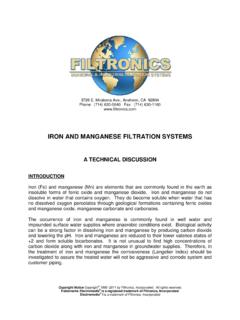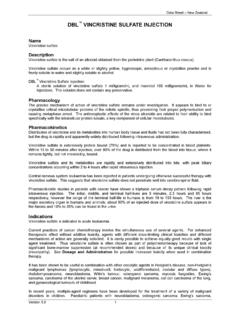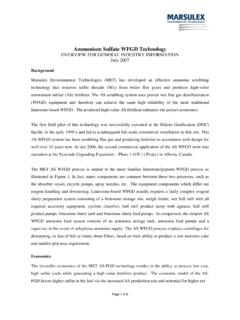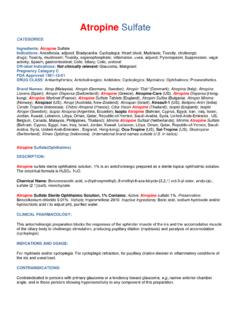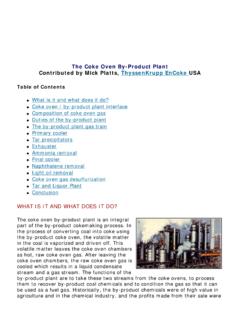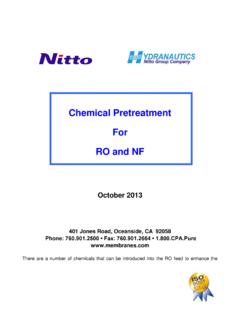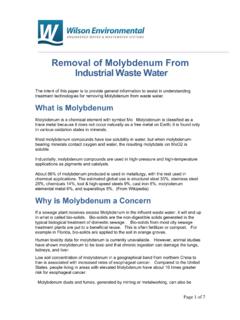Transcription of Hydrogen Sulfide Control and Removal
1 3726 E. Miraloma Ave., Anaheim, California 92806. Phone: (714)-630-5040 Fax: (714)-630-1160. Hydrogen Sulfide Control AND Removal . Hydrogen Sulfide is probably the most obnoxious and troublesome compound to be dealt with in a potable water supply. It is an almost impossible task to produce a palatable water that is free of taste and odor at all times if Hydrogen Sulfide is present in the raw water in significant concentrations. Not only does the treatment process require continuous surveillance, but the distribution system and consumers hot water systems require monitoring. Hydrogen Sulfide occurs mainly in well waters. Occurrence in surface supplies is primarily by groundwater intrusion; however, with the rising pollution of natural waters by sewage and industrial wastes, surface waters may become contaminated with Hydrogen Sulfide . Sulfides in well water are probably produced through chemical and bacterial changes under anaerobic conditions far underground. Sulfates may be reduced to sulfides by organic matter under anaerobic conditions, and the resultant metallic Sulfide changed to Hydrogen Sulfide by the action of carbonic acid.
2 The sulfate reducing bacteria (Desulfovibrio desulfuricans) are another source of Hydrogen Sulfide production. In anaerobic environments these bacteria convert sulfates and other sulfur compounds to H2S. They have a growth range of pH to and are found to exist in temperatures of 0 to 100 C, with an optimum range of 24 to42 C. Another group of bacteria also plays an important part in sulfur bearing waters. These are the Sulfide oxidizing forms. The most prevalent are Beggiatoa and Thiobacillus. Beggiatoa are filamentous white sulfur bacteria that obtain the energy necessary for their growth by oxidizing the Sulfide ion to colloidal sulfur, which is then stored in their cells. Brief exposures, (30 minutes or less) to H2S concentrations as low as percent by volume of air may be fatal. The gas is highly soluble in water to the extent of 4000 mg/l at 20 C and one atmosphere. The minimum detectable concentration by taste in water is given as mg/l. At pH 7, Hydrogen Sulfide is approximately 50 percent of the total dissolved sulfides; at pH 5, it is practically 100 percent of the total; at pH 9, it is nearly all hydrosulfide ion.
3 Therefore the existence of Hydrogen Sulfide in sulfur-bearing waters is pH dependent. This scientific fact has been well documented. Whenever the equilibrium between the hydrosulfide ion and the Hydrogen Sulfide in solution is upset, as when H2S is removed by oxidation, the shift will be to form more H2S from the remaining dissolved sulfides to reestablish the equilibrium. This stored sulfur gradually disappears by metabolic action, being itself oxidized to sulfate to yield more energy. The primary objection to waters containing Hydrogen Sulfide is the offensive rotten-egg taste and odor. The secondary objection is the marked corrosiveness of these waters to both metals and concrete structures. Another serious problem is their ability to promote luxuriant blooms of the various types of filamentous sulfur bacteria that lead to a general degradation of water quality in the system. The presence of H2S will turn silverware black, discolor lead base paint, make bathing in tubs or showers extremely unpleasant, and stain all plumbing fixtures.
4 The sulfides in the water react with iron from the mains to form a suspension of iron Sulfide that causes a discoloration of the water. This suspension makes laundering almost impossible. The presence of Hydrogen Sulfide is noticeable to the extent of ppm, even in cold water. If the pH is high, the odor may be slight. \\Server3\sales\Bulletins\EM-I\ Hydrogen Sulfide Control and Concentrations of H2S as low as ppm will promote the growth of Beggiatoa. The range of Hydrogen Sulfide concentration in usable sulfur waters is below 10 ppm. Notable exceptions are the Wadsworth Plant of the Southern California Water Company and the Santa Barbara supply, where the H2S content in the raw waters sometimes reaches 20 ppm. Hydrogen Sulfide is a flammable and extremely poisonous gas. The chemistry of the oxidation and Removal of Hydrogen Sulfide is extremely complex. Supposedly the oxidation proceeds to form either elemental sulfur, sulfate, or both. The assumption is that if enough chlorine is added to satisfy the natural chlorine demand of the water plus enough to react with the H2S present, then free sulfur will be formed and if more chlorine is added to satisfy the stoichiometric requirements then all the H2S will be converted to sulfates.
5 Unfortunately, this is not the case. When chlorine is added, regardless of the amount, to a sulfur-bearing water, colloidal free sulfur will be formed if enough chlorine is added to more than satisfy the natural chlorine demand of the water. This formation of free sulfur is readily evident as a milky blue turbidity (the Tyndall effect). Choppin and Faulkenberry state that the oxidation of the alkali sulfides is not simple and direct and may yield as end polysulfides, sulfites, and thiosulfates in addition to elemental sulfur and sulfates. The relevancy of this statement is based on practical evidence that most sulfur-bearing waters that have been treated for Hydrogen Sulfide Removal will exhibit some magnitude of odor in hot water systems. While the odor is not that of Hydrogen Sulfide , it is a sulfurous odor. Monscvitz and Ainsworth believe that this odor is the result of the formation of polysulfides in the oxidation reaction of Hydrogen Sulfide . Given time in days, these polysulfides will eventually oxidize to sulfates in the presence of dissolved oxygen in the water.
6 If dissolved oxygen is not present, as occurs in distribution systems, these polysulfides may be reduced back to Hydrogen Sulfide . The oxidation of Hydrogen Sulfide will produce colloidal sulfur which can be removed by filtration. Side reactions will produce polysulfides, which must be dealt with in order to eliminate threshold odors in the finished water. Monscvitz and Ainsworth suggest the conversion of colloidal sulfur and the remaining polysulfides to sulfates by first adding sulfite (which forms thiosulfate). and by converting the thiosulfate (S203) to sulfate by rechlorination. The reaction is very rapid. The formation of tetrathionate is not significant since it will convert to sulfate within a short time, with no contribution to any threshold odor. The sulfite ion may be added as sulfur dioxide in an aqueous solution or as sodium metabisulfite, bisulfite or sulfite. Metabisulfite has a strong, obnoxious odor. This reaction taken to completion is recognized as the typical dechlorination reaction.
7 Above pH polysulfides do not appear to form. This is probably one reason that any lime-softened sulfur-bearing water will not produce threshold odors resulting from these compounds. Probably the most important factor in Hydrogen Sulfide Removal is that of contact time. Given time and an oxidizing agent, all dissolved sulfides can be converted to sulfates. Aeration with contact times of up to three hours have shown Hydrogen Sulfide removals of 2 to 3 ppm and 35 to 45 percent Removal of dissolved sulfides. Shorter contact times and raw water concentrations of 5 ppm H2S reduced to 1 ppm by aeration, followed by coagulation and filtration, require free residual chlorine of up to ppm for the complete Removal of H2S. Derby reported in 1928 on the satisfactory Removal of up to 7 ppm by conventional lime softening and chlorination. Concentrations as high as 32 ppm have been successfully removed by pre and postchlorination, coagulation, and filtration. The final concern of the water producer is to protect the quality of the product in the distribution system.
8 This is difficult to accomplish because of the possible growth of sulfur bacteria. While the oxidizing forms that grow in an aeration tower may be beneficial because of their ability to convert the Sulfide ion to sulfates, they may find their way to the distribution system and in their life cycle slough off into dead ends and contribute sulfur compounds that under anaerobic conditions will start the entire Hydrogen Sulfide production cycle over again. For this reason chlorination for the Control of these organisms in the distribution system is of utmost importance. \\Server3\sales\Bulletins\EM-I\ Hydrogen Sulfide Control and Hydrogen Sulfide can be successfully removed by aeration and chlorination, followed by the addition of sulfur dioxide or sulfite for the Removal of polysulfides and colloidal sulfur and then rechlorination to convert all the remaining sulfur compounds to sulfates. The formation of Hydrogen Sulfide is pH. dependent and is encouraged by a lower pH.
9 Oxidation of sulfur bearing waters will produce colloidal sulfur that may cause a milky blue turbidity (the Tyndall effect). As the Hydrogen Sulfide is removed by oxidation, the equilibrium shifts to form more H2S from the remaining dissolved sulfides; depending on the amount of oxidant and contact time, this reaction can continue until all the dissolved sulfides are removed. When sulfur-bearing waters are oxidized, a combination of sulfur compounds are formed, including colloidal sulfur, polysulfides sulfites, and sulfates. Aeration, chlorination, coagulation, filtration, and softening have been used successfully for the Removal of H2S. Chlorination is extremely important not only as an oxidant but also as a germicide to prevent the growth of unwanted sulfur bacteria. Complete Removal of H2S can best be accomplished by oxidation by chlorine; conversion of resulting colloidal sulfur and polysulfides by metabisulfite or sulfur dioxide to thiosulfates, and then converting to sulfates by rechlorination.
10 Filtronics series of reaction vessels takes advantage of this mechanism by insuring break point chlorination and carrying a mg/l free chlorine residual to the distribution system for disinfection and sulfur bacteria Control . The reaction is begun in the first reaction vessel where all the forms of sulfur are produced. Between the first and second reaction vessel, sulfite is added where the thiosulfate is then formed. The thiosulfate oxidizes very rapidly producing a sulfate and a sulfite. Thus another sulfite is available to continue the conversion of any sulfur or polysulfides. By going to breakpoint and carrying a free residual through the system, re-chlorination is not necessary. \\Server3\sales\Bulletins\EM-I\ Hydrogen Sulfide Control a
